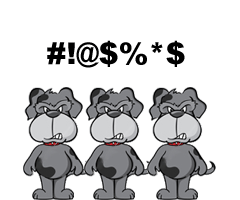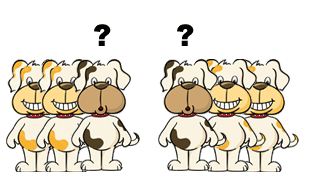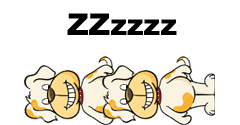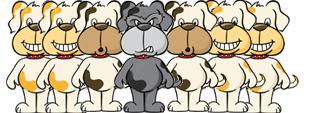What Your Dog Can Teach You About Building Teams
Filed Under Human FactorsOne of the most basic principles of building a team or organization is that there must be a balance of personalities. Without the correct ratio of Type A, B, and C personalities problems may arise. However, I have watched numerous organizations build teams with the wrong ratios of people.
For example, in the book Good to Great it is said to never hire Type B personalities. Type B personalities will only then hire Type C personalities and your organization will be tainted with people who are not driven to be the best. Why does Jim Collins go upstream against age old mantras such as:
Too many cooks in the kitchen spoil the soup.
Too many chiefs and not enough indians.
Too many officers and not enough privates.
In the end, people will always digress into basic wildlife pack behavior. We only need to look at the common house dog (or their wolf ancestors) to view the different personality types and the best blend of teams.
 Type A – The Guard Dog
Type A – The Guard Dog
Guard dogs are most associated with a Software Architect. This type of person is the obvious leader of the group, and will protect his team from anything that is not in the best interest of the team or project.
The most important note to make about the guard dog personality is that these people can be very friendly and open-minded, but mess with them and they will bite.
 Type B – The Alarm Dog
Type B – The Alarm Dog
Alarm dogs are like Sr. Developers. They are very smart and very aware of what is happening in the project, and therefore maybe acting as a leader in a small niche of the project.
Unlike the Guard Dog, these people will bark at approaching danger but will never bite. This might be because of lack of authority to execute, or just because of a lack of self confidence.
 Type C – The Happy Dog
Type C – The Happy Dog
Happy dogs are the Jr. Developers of software. If danger approaches they will lick its’ hand.
Although they may care about the project, these people are generally apathetic to the bigger decisions. Either they do not want the extra responsibility, have a serious lack of confidence, or just lazy, they just don’t care about decision making. They will follow Type A and B personalities without general questioning.
It is completely understandable why people would say they would want a team of only Guard Dogs or of just Happy Dogs, but by not having clear roles within the pack creates either confusion or contention.

Too many Guard dogs will fight with each other.

No Guard dogs will lead to lack of direction.

All Happy dogs will have no discipline.
In the end, you need a well balanced team. Limit the number of decision makers so that analysis paralysis does not occur, and have a good blend of future leaders and newbies to fill in the team. Doing so will allow you to survive in this wild we call software development.

6 Responses to “What Your Dog Can Teach You About Building Teams”



Building a team is difficult balance of personalities. There’s a concept called the Wolf Credo that applies habits of a wolf pack to team building that works well.
http://activeengine.wordpress.com/2008/02/11/brotherhood-of-the-wolf/
This true, we have some of those personalities here. Although you’re forgetting about the bad ones (lazy dog = people who avoid having to do work)
I liked the analogy. Thanks for the good read!
I understand you want to simplify the whole teamwork concept with an analogy; but its a bit dehumanizing and insulting to compare well, humans to dogs.
@kevin –
I prefer being with my happy dog over most people so I guess we can call it a wash… 😉
Nice post. Interesting change of perspective. I think everyone comes to this realization at certain points of their career, and it makes me look back with fondness at all of the Guard Dogs who watched over me when I was a puppy.